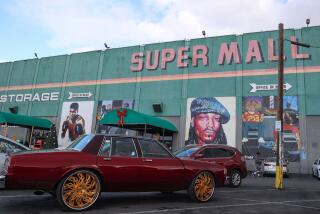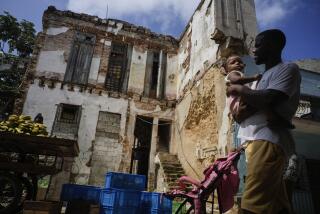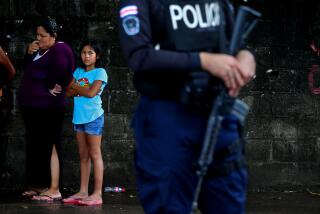Documentary : 4 Years Later: a Cuba of Peddlers and Pedalers : With few Communist allies left, tourism blooms but almost everything else has wilted since 1989, a visitor finds.
HAVANA â The first time I saw Havanaâs streets, they were a mobile car museum of glistening fins and running boards. When I rode through those streets again last month, the U.S.-made Fords and Chevies from the 1950s were mostly gone, replaced by Chinese-made bicycles.
Acute gasoline shortages have turned even the ancient automobiles--kept running with wits and clothes hangers--into luxuries saved for the most special occasions. So, an estimated 700,000 bicycles--mostly the heavy, old-fashioned type--have headed the shrinking list of Cuban imports in recent years.
They have taken over the right lanes of the cityâs broad boulevards, a symbol of the post-Cold War economic and political reality in Cuba.
On the ride in from the airport, the bicycles pass under a banner that reads, âCuba and Vietnam Together Will Triumph.â The Vietnamese Embassy recently moved from a small building behind the U.S. interests section--which substitutes for a diplomatic mission here--to one of the old mansions on once-fashionable 8th Street, in recognition of Vietnamâs increasing importance in Cuban foreign relations.
Cuba clings to Vietnam, China and North Korea as its few remaining allies in a world where Communist dictatorships are rapidly disappearing. The former Soviet Union and Eastern Europe accounted for $7 billion a year in Cuban imports--85% of the islandâs trade--before 1990. Last year, Cuba bought fewer than $1 billion worth of goods from those onetime allies, less than half its imports.
A radio reporter eagerly practicing English shifts to Spanish when she introduces a colleague, explaining that he studied Russian as his second language. âFor all the good it does me now,â he comments gruffly.
Western European languages are what Cubans looking toward the future are learning these days, as French oil companies start drilling offshore this month and the British invest in chemical plants.
Ironically, new foreign investment born of economic desperation has banished the ghosts of pre-Communist Cuba in ways that three decades of ideology could not. Not only are the old U.S. cars off the streets, but the city is outgrowing the skyline that U.S. hoteliers created in the 1940s.
A Spanish-owned hotel under construction already overshadows the old Riviera at the harbor entrance. The new building is controversial, with postmodern architecture that looks odd in a city where no landmarks have risen in more than 30 years.
A Spanish company has also taken over the old National Hotel, replacing the worn, clunky 1950s furniture with more contemporary designs.
As a result, on my first walk through Havana in four years, the city--despite its economic crisis--actually felt less than it had before like a fading âTwilight Zoneâ set, a place waiting nostalgically for Papa Hemingwayâs return.
The Havana of 1989, with its old cars, peeling paint and long lines, could not have been considered prosperous, at least not by any standards except those of Cuba today. The economy had stagnated during the previous four years. Stores routinely ran out of many items in ration books. Pens and paper were scarce.
Against all odds, Cubans in 1989 were already getting ready to host the 1991 Pan American Games. As a foreign student on a study tour of the island, I was amazed to see workers shoveling cement out of wheelbarrows to lay stadium foundations and could not imagine that the buildings would be ready on time. Later, I learned that the stadiums started to crumble almost immediately. But they were done on time.
Today, I remember my skepticism about the sports arenas when I hear people debating how much longer President Fidel Castro and communism can last.
âWhat is remarkable is the extent to which Cuba has maintained its economic stability,â said economist Andrew Zimbalist. âAusterity has been shared equally. Starvation has been avoided.â
But other problems have not been. As the economy has shrunk by half over the past four years, some industries have ground to a halt while others, notably tourism, have grown 30% or more. The uneven way the economy has contracted creates the same kinds of distortions that boom towns suffer.
Prostitution, the black market and the split between dollar haves and have-nots are more blatant today than they were four years ago. Then, police routinely questioned students who stood outside hotels talking to tourists, especially if they wore makeup or nylon stockings--evidence of fraternization with foreigners.
Now, young women in red tube dresses walk down 5th Street, the cityâs main drag, in midafternoon, hailing cars that only tourists can afford to drive. No one stops them. In a city where most youths are out of work, they have found a way to earn a living in dollars.
Obtaining dollars has become an obsession. The official exchange rate is still one peso per dollar. But the peso has been devalued drastically on the black market, from six pesos per dollar four years ago to 60 per dollar now. That sounds like a bargain until you try to buy something with those 60 pesos. Restaurants and hotels have always demanded dollars from tourists. Still, four years ago, my fellow students and I bought stacks of books and cassettes with pesos.
Today, bookstore shelves are as bare as those in any other shop. There is no paper for printing, no tape for recording.
In contrast, the dollar stores for tourists are full of imported cookies, rolls of cloth and even blenders. When no Cubans were legally permitted to have dollars, people stood outside the dollar stores asking tourists to buy them tennis shoes. Everyone was in the same situation. Now that Cubans who work in tourism are allowed to exchange their dollar tips for scrip that is good at the special stores, resentment is growing. Those pressures have forced the government to promise to let everyone hold foreign currency.
âWe just need some time to work out the details,â said Raul Amado, deputy director of the central bank.
But Cubans are becoming increasingly skeptical of slow-moving bureaucratic solutions. As the formal economy offers less--fewer jobs, fewer goods--Cubans are turning to the black market. Zimbalist estimates that the informal economy has quintupled to $10 billion over the past four years, undermining faith in the state-planned economic system.
âWe have a price-setting committee with a huge bureaucracy to decide how much rice, beans and everything else should cost,â said a professor. âBut I have noticed that on the black market, with no committee setting the prices, a vegetable that costs 5 pesos down by the seawall also costs 5 pesos across town. So why do we need this bureaucracy?â
In other ways, the struggle for survival has come to overshadow concerns about ideology.
Four years ago, I sat in the living room of a Cuban family, sipping rum and listening to a spirited debate about which criticisms of the system were ideologically legitimate and which were not.
Now, conversations center on the last time someone ate pork or how long the electricity was off that day in different neighborhoods. People no longer even comment on the unfairness of spending evenings without light while three different kinds of generators and duplicate power lines assure that the hotels at Varadero Beach are never without electricity.
Cubans are uncharacteristically fatalistic as they contemplate a future only expected to get worse.
âI had thought we would hit bottom in 1993, but I had not counted on the weather: rain in January that ruined the sugar harvest, a hurricane in March and flooding in early June that forced the evacuation of 60,000 people,â said Octavio Castilla, vice president of the State Committee for Economic Cooperation. âNow, I do not know where the bottom is.â
But contrasted with such grim predictions are other factors--a doubling of oil production, thanks to better recovery techniques; more nickel mines, and all those shiny new and refurbished hotels.
âWhen I am in Havana, my perception does vary, day to day and within days,â says Gareth Jenkins, a British business consultant. âWhen there is an eight-hour blackout and the ministries canât work, the situation seems hopeless. Then, I talk to business people who are convinced there is an economic bonanza on the way and (who) want to get deals signed up before the Americans come back.â
More to Read
Sign up for Essential California
The most important California stories and recommendations in your inbox every morning.
You may occasionally receive promotional content from the Los Angeles Times.










